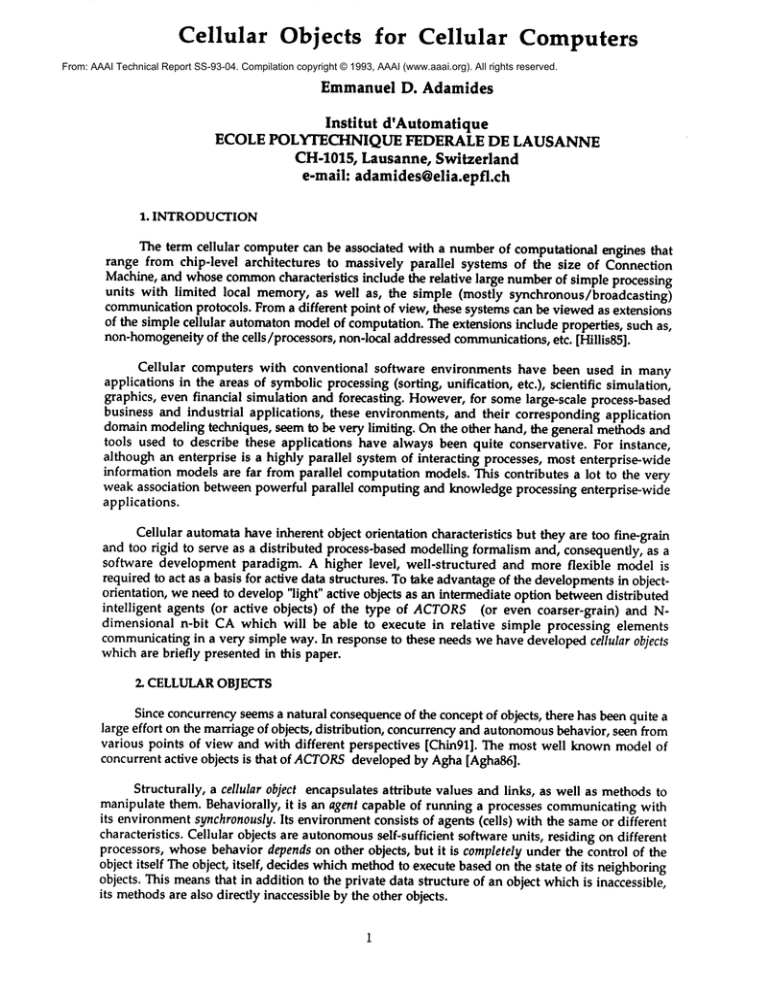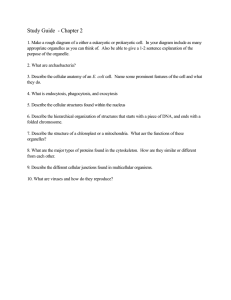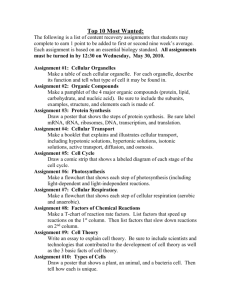
Cellular
Objects
for Cellular
Computers
From: AAAI Technical Report SS-93-04. Compilation copyright © 1993, AAAI (www.aaai.org). All rights reserved.
Emmanuel D. Adamides
lnstitut
d’Automatique
ECOLE POLYTECHNIQUE FEDERALE DE LAUSANNE
CH-1015, Lausanne, Switzerland
e-mail: adamides@elia.epfl.ch
1. INTRODUCTION
The term cellular computer can be associated with a number of computational engines that
range from chip-level architectures to massively parallel systems of the size of Connection
Machine, and whose commoncharacteristics include the relative large number of simple processing
units with limited local memory, as well as, the simple (mostly synchronous/broadcasting)
communicationprotocols. Froma different point of view, these systems can be viewed as extensions
of the simple cellular automaton model of computation. The extensions include properties, such as,
non-homogeneityof the cells/processors, non-local addressed communications,etc. [Hillis85].
Cellular computers with conventional software environments have been used in many
applications in the areas of symbolicprocessing (sorting, unification, etc.), scientific simulation,
graphics, even financial simulation and forecasting. However,for somelarge-scale process-based
business and industrial applications, these environments, and their corresponding application
domainmodeling techniques, seem to be very limiting. On the other hand, the general methods and
tools used to describe these applications have always been quite conservative. For instance,
although an enterprise is a highly parallel system of interacting processes, most enterprise-wide
information models are far from parallel computation models. This contributes a lot to the very
weak association between powerful parallel computing and knowledge processing enterprise-wide
applications.
Cellular automata have inherent object orientation characteristics but they are too fine-grain
and too rigid to serve as a distributed process-based modelling formalism and, consequently, as a
software development paradigm. A higher level, well-structured and more flexible model is
required to act as a basis for active data structures. To take advantageof the developmentsin objectorientation, we need to develop "light" active objects as an intermediate option betweendistributed
intelligent agents (or active objects) of the type of ACTORS(or even coarser-grain) and
dimensional n-bit CAwhich will be able to execute in relative simple processing elements
communicatingin a very simple way. In response to these needs we have developed cellular objects
whichare briefly presented in this paper.
2. CELLULAROBJECTS
Since concurrencyseems a natural consequenceof the concept of objects, there has been quite a
large effort on the marriage of objects, distribution, concurrencyand autonomousbehavior, seen from
various points of view and with different perspectives [Chin91]. The most well knownmodel of
concurrent active objects is that of ACTORS
developed by Agha[Agha86].
Structurally, a cellular object encapsulates attribute values and links, as well as methodsto
manipulate them. Behaviorally, it is an agent capable of running a processes communicatingwith
its environmentsynchronously. Its environmentconsists of agents (cells) with the sameor different
characteristics. Cellular objects are autonomousself-sufficient software units, residing on different
processors, whosebehavior depends on other objects, but it is completely under the control of the
object itself The object, itself, decides whichmethodto execute based on the state of its neighboring
objects. This meansthat in addition to the private data structure of an object whichis inaccessible,
its methodsare also directly inaccessible by the other objects.
Comparedto ACTORSthat use asynchronous buffered communication, cellular objects use
(SCCS-like) broadcasting for communication. Only the states of objects are communicated. While
ACTORS
can be created dynamically at run time, cellular objects are defined statically at compiletime and they "live" until the end of the execution of the program. However,they maybe connected
or disconnected from the rest of the environment, at run-time, as dictated by the state of the
environment/neighborobjects. This is done by manipulationof their connecting ports. In order to cope
with real-time cooperation-intensive application requirements (full determinism), and at the same
time be simple, instantiated cellular objects use the static notion of one-object/one-process/oneprocessor. This schemeremains constant during run-time.
Formally, a cellular object is defined by the 8-tuple
0 = (o, Qst, Qm,]~acc, r, m, H, M)
where:
o is the nameof the object,
Qst is the set of states of the object as they are defined in the data structure,
Qmis the set of states which are used for the selection of the communicationports and the
methodsto be executed (modeselection states),
~acc is the set of acceptable input events that are limited to the parallel composition with
full synchronisationof the of the states of the neighbourobjects,
r is the set of neighboursof the particular cell,
m is the methodselection function
m = F(qst, qm’°aoc’ H)
where
H is the neighbor vector which supplies the information regarding which neighbor of each of
its neighboursthe specific object is, and finally,
Mis the set of the methodsthat manipulate the object’s states including the modeselection
states. All methodsare functions of the elements of Qst and ~acc.
The instantiation of a numberof cellular objects forms a cellular object graph (COG).The COG
is paced by a global clock as cellular objects always communicatingwith each other. They do so,
even whenthey have nothing to say or even whenchange of state means"freeze at the same state".
A cellular object, at each time step, senses the states of the (interesting) neighbours, reads its
neighbor vector, chooses one of its methodsthat will execute, and finally changes its state according
to this method.All methodsmanipulate, in someform or another, the current state of the object, as
given by
currentstate =data state (qst) + selectionstate (qm)
The global cellular object evolution function is the synchronousconcurrent composition of the
methods that are executed at every time step, and which mapsa global system state of the graph at
a time instant to a new global state of the graph at the next time instant. Apparently, the global
object matrix states represent the states of the global application domain. Figure 1 shows the
internal as well as the communications
structure of two active cellular objects.
Object A
~ates
Object B
methodselection functions
FigureI : Cellular Objects
Communicationbetween the cellular objects themselves, as well as between the cellular
objects and the external environmentis fully synchronous, based on the so-called approach for realtime and reactive systems (e.g. see [Benveniste91]). In addition, cellular objects are reactive in a
sense that their behaviour is simply their reaction to the information broadcasted by the other
objects.
According to the characteristics of the synchronous approach to reactive real-time systems,
the (state) output of an object is synchronouswith its input, the execution of the invoked method
instantaneous and the communicationsare performedvia broadcasting, i.e. the state of the object is
broadcasted to the connected cellular objects. If it is not used by the connected objects this
information is lost. There are no message queues as in the (asynchronous) ACTORS
model.
Figure 2 shows in some detail the synchronous operation and communicationof two cellular
objects, initially, the methodselection function is executed with the current and the neighbor states
(as it is seen through the neighbor vector) as parameters (1,2). Following, the selected method
executed and the result updates the object state (3). Finally, the object state is broadcasted to the
neighbouring objects (4). It should be noted that these steps form an atomic operation and they
cannot take place separately, i.e. once the operation starts, all steps have to be performed. Being
reactions, they take no time in the sense that they take no time with respect to the external
environment which remains invariant during the operation. In absolute terms, they take one time
unit of the global clock. The period of the global clock should be long enoughto allow for the object
with the larger methodto execute.
Cellular objects that have no methods (only data structure definition) are called dummy
cellular objects. Their states are set and reset externally in the same waythat static memoriesare
set and reset. In addition there are commandor interrupt objects which store only the nameof the
methodwhichmust be executed with the highest possible priority, no matter of the state of the rest
of the cellular object graph, at the next time step. In other words, they provide the buffered
channels through which interventions from the external word (the user). Auxiliary objects
implementcounters of time instances are parametric in the numberof instances, and a sufficient
numberof such objects has to be provided for each control architecture.
Object A
Object B
¯¯o¯°°¯¯¯°¯¯o
¯¯¯°¯¯¯¯¯¯¯¯¯¯
¯¯°¯¯°¯¯¯¯¯¯¯¯o
4
.¯¯,¯
¯°¯¯¯¯
¯¯°¯¯°¯
¯
°
¯
¯
¯
¯
° ¯ ¯ .....
¯ ¯ ¯ ¯ ¯ ¯
¯ ¯
°
,
*
°
°
¯
¯
°
°
¯
¯
¯
¯
¯
¯
¯
¯
¯
,
°
°
¯
°
°
¯
¯
¯
°
¯
¯
¯
°
°
¯
¯ ¯
°
¯
¯
¯¯
¯°
¯o
°¯
2
¯¯¯°¯.
¯¯¯¯°¯¯
¯¯¯¯¯°
Figure2: Operation(reaction) of Cellular Objects
3. THE USE OF CELLULAR
OBJECTS
So far, cellular objects (CO)have been constructed only as discrete-event simulation modelsfor
two, apparently, diverse applications,
namely factory-level
automation [Adamides92a] and
Computer Supported Cooperative Work (CSCW)[Adamides92b]. Both, however, within the
frameworkof our effort towards fine-grain enterprise-wide process-based modeling with the final
aim to use cellular computersas information processing machines for the non-hierarchical clusterbased enterprise of the future.
In the first application, for the first time, notions of massive parallelism have been
introduced into the factory, as a large number of COis used to perform, employing distributed
knowledge-basedtechniques, the factory supervision task. The overall control task is decomposed
into sub-tasks of cooperative, fully deterministic control demolishingall the unproductive decision
and control hierarchies of the shop floor¯ All factory decision points are substituted by active
cellular objects which perform the control task by cooperating with each other, as well as, by
interacting with the physical environment¯
Since in most modern flexible factories, machines and their related hardware are organized
in various islands of automationintegrated into larger units such as Flexible ManufacturingSystems
(FMS), coordination should be provided at, at least, two levels: at the level of individual cell
component, i.e. the machines and the material and tool transportation systems, as well as at the
level of the shop-floor wherethe operation of the different cells and their interactions have to be
coordinated.
Multi-level structures wherecellular object graphs are coordinated by cellular objects which
belongto higher level cellular object graphs can be used for the coordination of cellular shop-floors.
By using a systolic-like information flow [Adamides92c] between the various control levels,
coordination at the factory level can be achieved¯ Special cells, called transporters, transport state
information to different level cellular graphs. Transporter objects contain special methodscalled
filters that automatically "filter" the state of the object before it is broadcastedto a different level
cells.
For the case of the CSCW,
real-time distributed meeting scheduling has been chosen since it
can be decomposedinto a large numberof fine- to medium-graincooperative tasks. The structure of
the cellular graph represents the structure of the application environment which, for the case of
large organizations,
may be enormous. Hierarchical decomposition techniques based on CA
hierarchical structures [Adamides92c] have been employed. Cellular objects represent the
individual participants processes and schedule meetings by cooperation. Having the synchrony
property, cellular objects overcomethe real-time burden quite easily. Figure 3 shows, in moredetail,
the structure of a cellular object used in this application (Figure taken from [Adamides92b]).
cellular_object: Gli;
data:
exposed-atates: < null, [12-15]>;
hidden_states : < 7-11>;
method_sel_states : < null, ALL_TRIED,
LOCK>;
connections:< con1, con2, con3, con4, conS,con6>;
states_accepted : < [0.24], rooms, commands~
data_types>;
/ rooms and commands
are complexdata types
neighbours: < GT, GS, G9, G10, G12,G17,Glldl, Glld2,
G11d3, Gllcoml, Gl.lmm2>;
/ neighboursare ordered anti-clockwise; by
/d are identified the associated with the cell data cells and by
loomthe associated command
cells.
neighbour_vector: <G7(1), G8(2), G9(3), G10(4), G12(1),
methods:
check_update_state;
expose;
propose;
apply_filter,
check_majority_act;
/ for groupleader objects
/ if votingis used
method_selection_function(exposed_states, method_sel_states, states
_accepted);
if methodsel state --- null then check_update_state;
¯ * e, ¯ e, ¯ e*e ¯ e* o* ee Q¯ e* ¯ * oe ¯ ¯
if exposed_state--- null & methodsel state = null then propose;
if method’_’s’e’l’_sta;e" ALL-Ti~"
;/~n expose;
eooeooeoeeeooeoeooe.ooo.eo.e
Figure 3: Cellular object for real-time meeting-scheduling application
4. CONCLUSIONS
Cellular objects have been developed in order to execute on simple connected processing units.
They have a simple communicationmechanismthat supports large numberof connections for fine- to
mediumgrain parallel architectures. The structure of the cellular object graph can dynamically be
self-reconfigured at run-time. In addition to acting as a modelling and developmentmedium(active
data structure) for various symboliclarge-scale applications in business and industry, cellular object
graphs, themselves, can be used as a paradigm for the development of novel massively parallel
architectures for AI.
REFERENCES
[Adamides92a]Adamides, E.D. and Bonvin D., "A Cellular Control Architecture", Proc. IFAC
Intelligent Manufacturing, Dearborn, MI, 1992.
[Adamides92b] Adamides, E.D., "Modelling Real-time Distributed Meeting Scheduling with
Cellular Objects", submitted to Software EngineeringJournal (1992).
[Adamides92c] Adamides, E.D., Tsalides, Ph. and Thanailakis, A. "Hierarchical Cellular
AutomataStructures", Parallel Computing,18(1992), pp 517-524.
[Agha86] Agha, G.A., "ACTORS:A Model of Concurrent
Systems", The MITPress, (1986).
Computation in Distributed
[Benveniste91] Benveniste, A. and Berry, D., ’The Synchronous Approach to Reactive and
Real-Time Systems", Special Section on Another Look at Real-Time Programming",Proc. IEEE, Vol.
79, No.9, (1991), pp 1270-1282.
[Chin91] Chin, R.S. and Chanson, S.T., "Distributed Object-based ProgrammingSystems",
ACM
Comp.Surv., Vol. 23, No. 1, (1991), pp 91-24.
[Hillis85] Hillis, W.D., "The ConnectionMachine", The MITPress, 1985.









